Cross Country RV Trip Guide
How Long Does A Cross Country RV Trip Take?
There are several blogs and plans that share different 30-day coast-to-coast trip ideas; however, the duration largely depends on what people want to see, how often they want to stop and how much time one wants to take traveling.
For travelers who want to simply “blitz it”, a trip from Los Angeles to New York is about 2,800 miles long, which would take a person about 7 days when driving an average of 400 miles a day and driving every day.
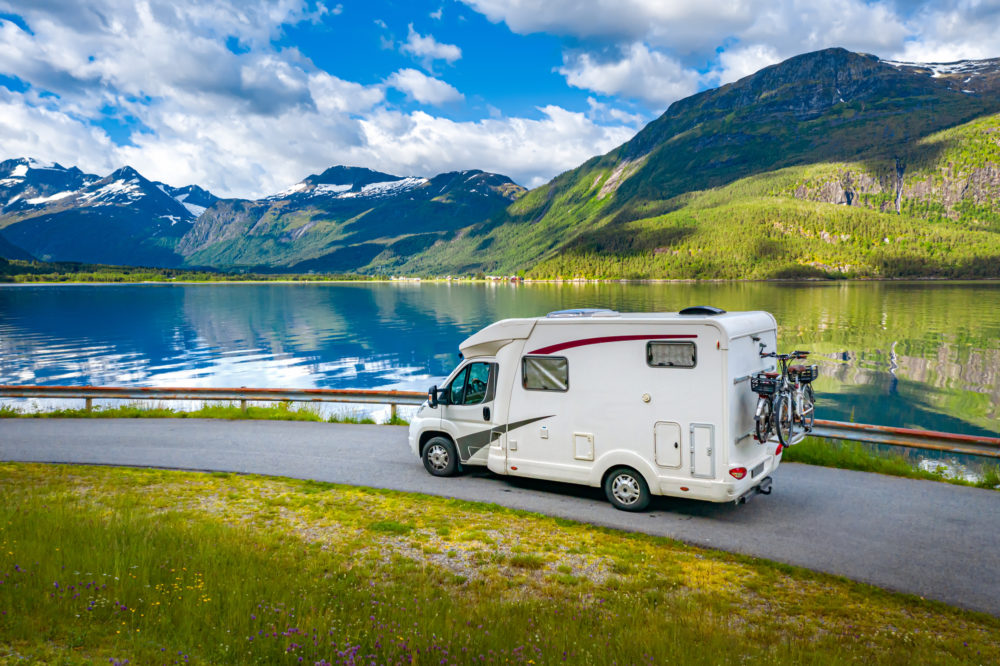
Contents
However, most people travel across the US in order to see different States, landmarks, visit family members, or to add-on stickers to their RV collection. Because of that, most trips are not linear coast-to-coast trips, but individual itineraries with various different stops and fun “detours” across several different states.
This way, it is entirely possible to spend several months traveling across the US.
Are RVs Good For Long Road Trips?
RVs are great for road trips, because it gives one great flexibility when traveling. When traveling with the RV, you have your “hotel room” with you wherever you are. In addition to that, you can stop during your trip and use the RV bathroom, fridge or seats to take a break.
The only downside lately has been the huge increase in fuel prices that makes it much more expensive to travel with the RV.
How To Plan A Cross Country Round Trip
- Start with your final destination in mind (considering all planning constraints, such as road closures, fuel cost/budget etc.).
- Use Google Maps or another trip planning app to look at the possible routes leading from your starting point to your destination.
- Map out a route, adding the top places you want to visit as stops.
- Break down your travel time into manageable daily drive segments.
- Find RV parks on your route stops. Use apps with visitor reviews to narrow down the list of parks to those who are a good fit for you.
- Review the RV parks for cost, feedback and possible availability restrictions (such as seasonal parks, military parks or age restrictions).
- Call or book online and save your reservation info.
Best RV Trip Planners:
- RV Life Trip Wizard (one of the top choices for RV trip planning, incl. finding safe routes and great campgrounds)
- The Dyrt Pro (annual subscription includes trip planner and offline search)
- KOA (database of all KOA’s in the US network)
- Campendium (great app for boondocking/free camping)
- Roadtrippers (road-trip planning app, shows all the cool stops between point A and point B)
- Hipcamp (one-stop app for all unique ways of camping: glamping, treehouse rentals etc.)
- RV Parky (great app for cross-country planning)
- ParkAdvisor (RV parks database created by RV parks and visitors, comprehensive reviews)
- Allstays (RV parks database)
- Harvest Hosts (free or cheap stays on US-wide participating spots with a paid membership)
- Gas Buddy (free trip budget calculator)
RV Route Trips Across America
There are several “bucket-list” cross-country routes that are worthwhile:
Route 66 (AKA The Classic) from Los Angeles, CA to Chicago, IL
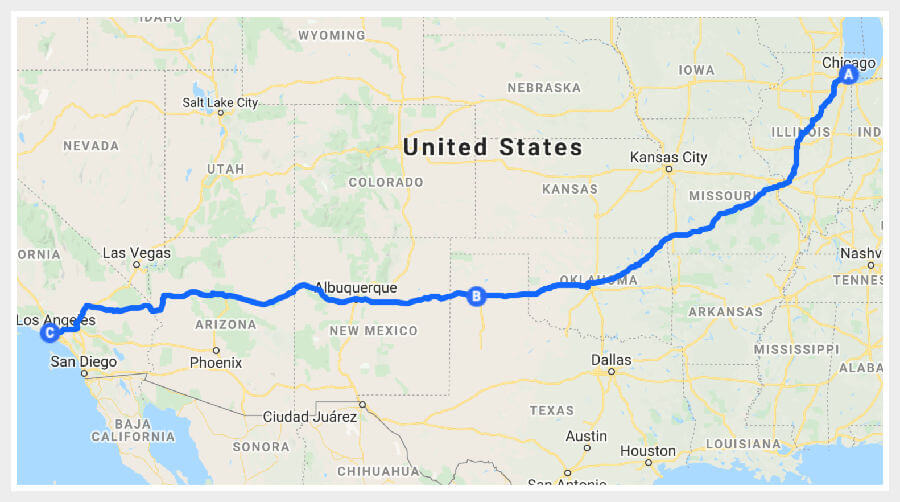
Pacific Highway Coast from San Diego, CA to Seattle, WA
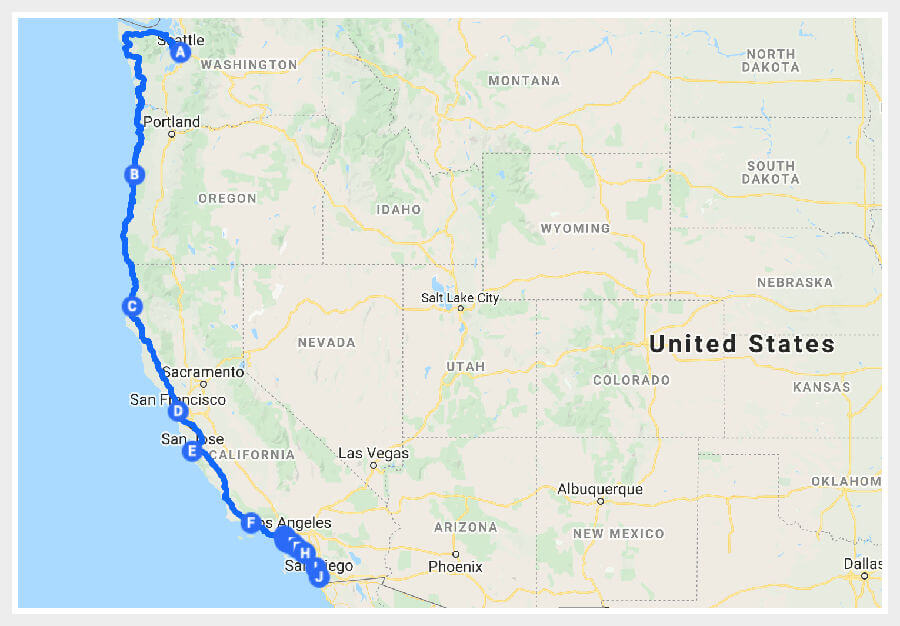
Route 50 (AKA The Loneliest Road) from Sacramento, CA to Ocean City, MD
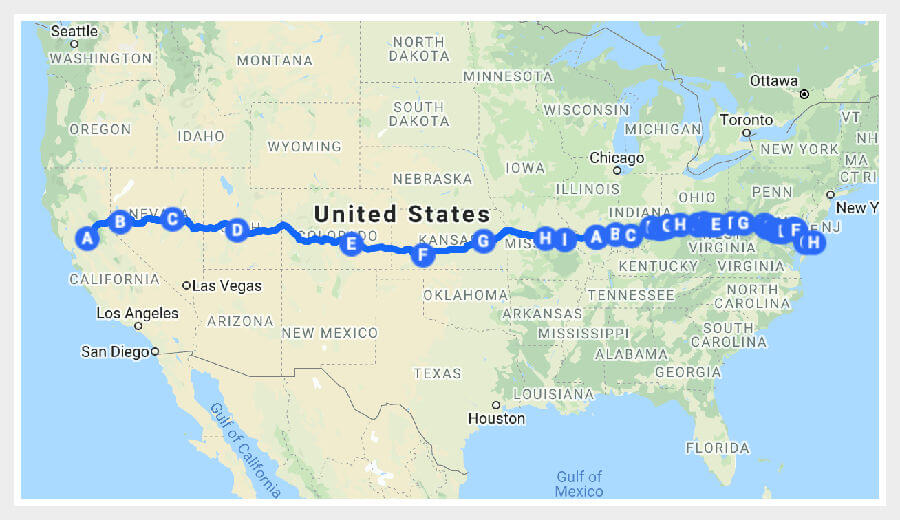
Highway 2 (AKA The Great Northern Road) from Seattle, WA to Acadia National Park, ME
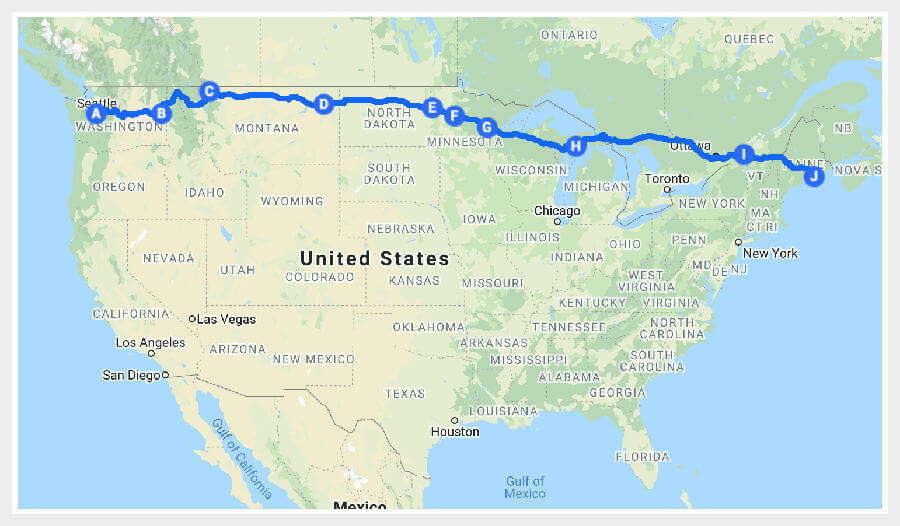
The Oregon Trail from Provincetown, MA to Cannon Beach, OR
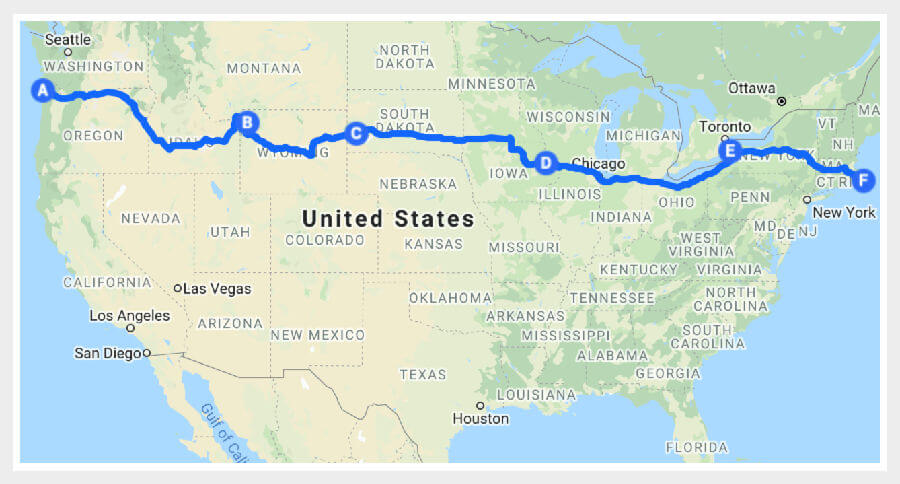
The Atlantic Coast from Maine to Florida
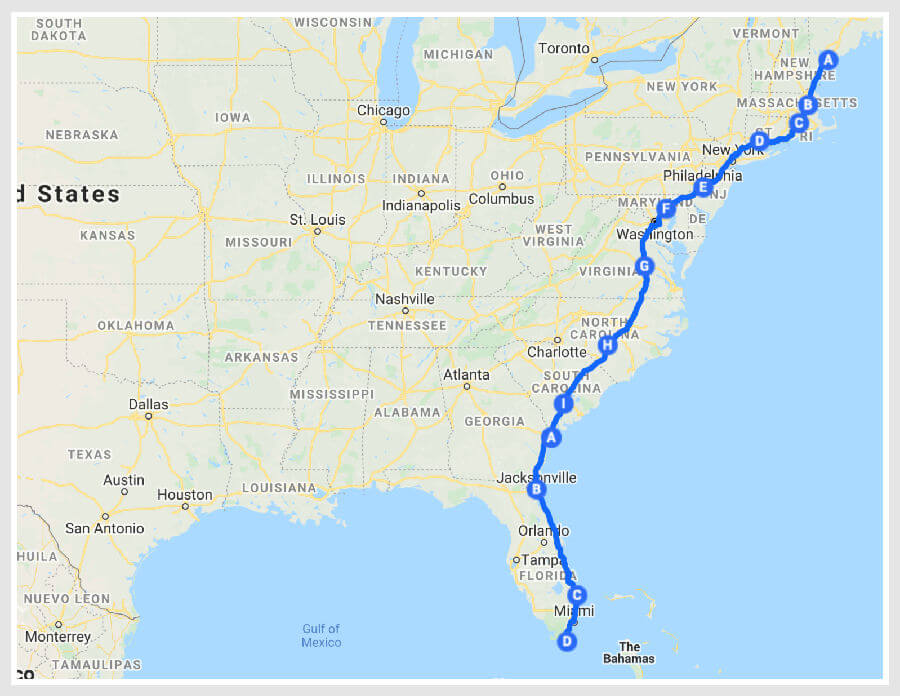
The Blue Ridge Parkway from Great Smoky Mountain National Park, NC to Shenandoah National Park, VA
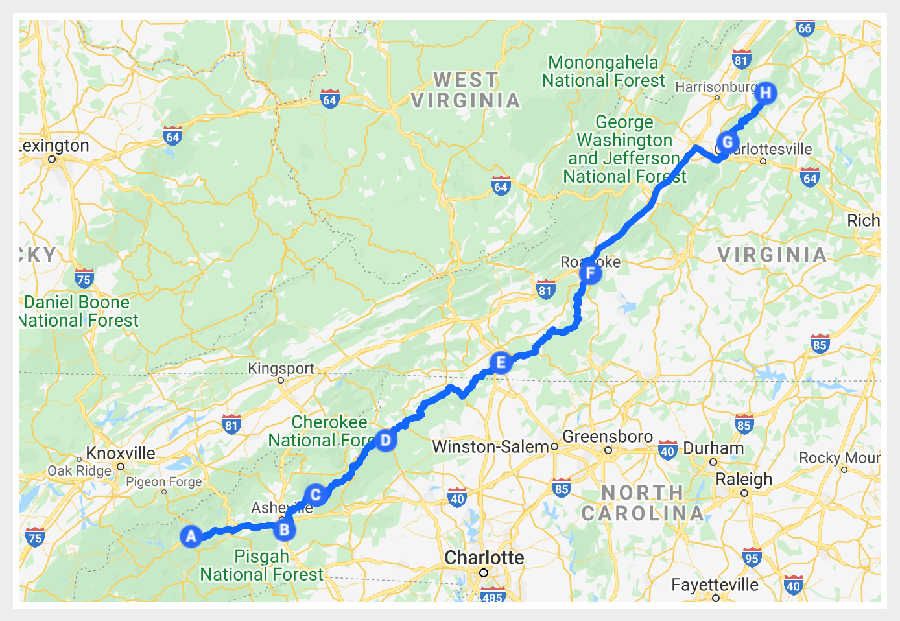
What major cities should be avoided?
During your travels with an RV, it can be very stressful to travel through large cities. While it is possible to pull a 35-foot fifth-wheel through downtown Houston, it’s not really anyone’s idea of fun. Whenever possible, try to avoid high-stress areas and set your GPS to avoid large metropolis areas where you can even get stuck with your RV if you happen to take a wrong turn (this might have almost happened downtown Atlanta, where the roads got more and more narrow very quickly).
Sample 2-Week Cross Country RV Trip Itinerary
Depending on one’s preferred travel tempo and lately, fuel budget, below is an example itinerary for a 2-week cross country trip:
Day 1: drive from San Diego, CA to Phoenix, AZ
Day 2: spend the day in Phoenix, visit the ZOO, go for a hike etc.
Day 3: drive from Phoenix, AZ to Las Cruces, NM
Day 4: drive from Las Cruces, NM to Fort Stockton, TX
Day 5: visit the museum, get some BBQ
Day 6: drive from Fort Stockton, TX to Austin, TX
Day 7: sight-seeing in Austin, TX
Day 8: spend the day at the park or find fun things to do in Austin, TX
Day 9: drive from Austin, TX to Beaumont, TX
Day 10: sight-seeing or recovery day
Day 11: drive from Beaumont, TX to New Orleans, LA
Day 12: sight-seeing in New Orleans, LA
Day 13: check out some local eateries etc.
Day 14: arrive in Destin, FL
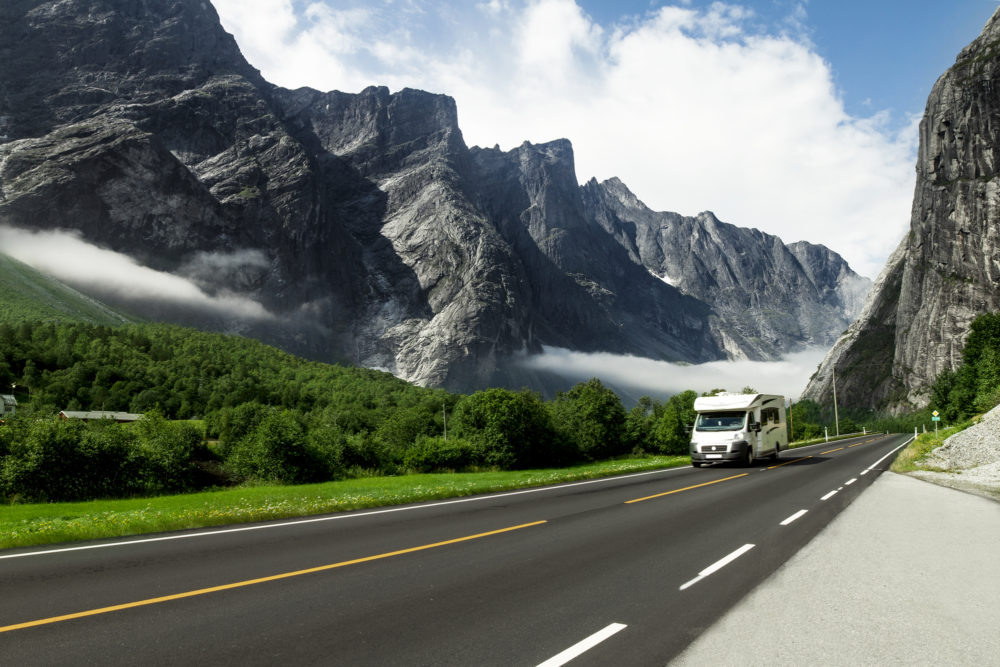
How Much Does A Cross Country RV Trip Cost?
There are several considerations one should take into account when budgeting a cross-country trip with an RV. In fact, many rookies fail to do this and either overspend or they realize that this kind of travel ends up doubling in expected expenses.
Some of the things to include in the budget are gas, food, RV rental or payment, insurance cost, as well as entertainment budget. While some costs are fairly fixed, other items can provide some wiggle room based on personal preferences and adjustments.
For example: one can offset the rising fuel prices by spending fewer days driving and staying at an RV park for an extended period of time. The same applies for the food budget: one might opt out of eating out and prepare meals sourced from local farmer’s market instead.
Below is a sample budget for a family of four that is traveling the RV cross-country trip from San Diego, CA to Destin, FL (listed above):
Fuel: approx. $1,500 (based on distance and average nationwide fuel cost)
Food: $80*14=$1,120 (this is conservative with very few times of eating out and based on two adults and two children)
RV payment vs rental: *$500/month if financed*, $150/night ($150*14=$2,100)
RV parks: $55*14=$770
*Insurance: $160/month (if RV is owned)
Entertainment, souvenirs, park entrance fees etc.: $60*14=$840
Overall, one can expect to spend between $4,640 and $6,330, depending on renting vs owning an RV. Again, this amount would greatly vary based on one’s choices of eating out vs eating in, traveling more or staying longer in one place, paying for entertainment or finding free things to do etc.
Can You Rent An RV For A Cross-Country Trip?
What are the daily/weekly rates?
The rental fees vary greatly depending on the type of RV one wants to rent, as well as the age and condition of the unit. Also, it depends whether one rents from a private party vs an RV dealership/rental place.
On average, a Class A that is 10 years or newer can run from $200-400/day, while a travel trailer costs on average $150/day. There are some more economical options, especially when renting from an RV park directly (and not traveling), or renting on a military base (those units are often very basic, but also very affordable).
Keep in mind that you must often also provide a deductible or safety deposit, in case damage to the unit were to occur.
Some recommended websites or rental companies for RV rental include RV Share, Outdoorsy, Cruise America or El Monte RV.
What’s the cheapest way of renting an RV?
The cheapest way is to purchase a used unit that is about 2-3 years old. However, if one must rent out an RV (maybe to see whether the RV lifestyle is a fit), the most economical way would be to rent from a private party, such as a relative or an acquaintance.
What are the requirements that rental companies ask for?
Most companies require at least one driver to be over 25 (depending on company) with at least 8 years of driving experience and a valid driver’s license. As mentioned before, many also require a safety deposit in case of damage. Towing an RV is quite different from driving a car and the unit can be easily damaged when not used properly.
The tow vehicle must also be adequate to tow the RV, whenever applicable.
What Do You Need To Pack For A Cross-Country Trip?
There are many basic RV pack lists on the Internet that one can download and customize, such as https://www.campanda.com/magazine/rv-checklists-printable/ or https://togorv.com/rv-living/how-to-pack-your-rv/.
Consider each space as a pack sub-list, such as kitchen, bathroom, bedroom etc.; the packing list becomes a consolidation of one’s needs and preferences, from must-have’s (like plates and cups) to nice-to-have’s (did you know that there are RV wine glasses?).
There are internal and external packing lists when it comes to mechanical/maintenance items. It is always helpful to have some spare fuses and flashlights, and it is imperative that one has a basic toolbox, as well as the “stinky slinky” setup.
While a first-time trip might seem overwhelming and one might be tempted to overpack, most places offer access to RV supplies should you forget anything. With each trip you can take notes on what to bring next time and what merely uses up space.
Is It Safe To Take An RV Trip?
Traveling safely in an RV is a primary goal for all. There are many items that are required, some that are helpful and several veteran hacks that help rookies to travel better. With regard to possible accidents or breakdowns, RV insurance and roadside assistance are a must. One should know where the spare tire is and how to replace it in case of a blow-out.
As mentioned above, one should have a basic toolbox to have the tools for standard repair. Part of the standard maintenance is re-tightening of tire lug nuts, greasing of axles and roof maintenance to avoid roof leaks.
When traveling as solo females, there are several RV support groups(such as RVing Women, Sisters on the Fly or Freewheelers) that help females to stay safe on the road. Many women also choose to travel with a dog as a guarding companion. There are also different safety tools that help women stay safe, the biggest one being the 2A (check each State law). It is also a good idea to let your family know of your trip plans, estimated itinerary, regular check-in and “shared location” on phone GPS.
FAQs
Is it cheaper to sleep in an RV than stay in hotels?
It used to be cheaper to stay in an RV than to stay in an hotel, but with the increase in gas/diesel cost, as well as overall overhead costs of RV parks that are reflected in the increase in park fees, the stay in an RV is only more economical when staying for a longer period of time.
One must also research to find cheap RV parks that might be more basic in amenities and located at less glamorous places.
What is the best RV for traveling?
This question is equivalent to “what’s the best thing to eat for breakfast?” This question can only be answered on an individual level: adventure-loving singles might love the nimble travel with a teardrop trailer to access remote areas of the US (and all National Parks), young families might be able to enter the RV lifestyle with an ultra-lite travel trailer that provides all the amenities and space for all, but does not require an expensive towing vehicle, while a full-timing couple might purchase a luxury Class A to replace their “sticks and bricks” home.
Can you park an RV anywhere in the U.S.?
There are designated private, state and federal parks where one can park and stay overnight. Also, some big corporations allow overnight stays on their premises. Some examples include Big 5, Walmart or The Cracker Barrel.
Other options for creative and affordable stays are The Dyrt app where individuals can post their private land for camping/RV stay, or Harvest Hosts membership, which is a database of wineries, farms etc. who allow RVs to stay at their property for no or a small fee.
How far can you travel in an RV in a day?
The rule of thumb that is used by several RV veterans is like this: no more than traveling for three days in a row, no more driving than 300 miles a day, and arriving no later than 3 PM at the next destination.
However, when people are in a time crunch, this rule of thumb can be extended to traveling 5 days in a row, for up to 500 miles and keeping a 5 PM arrival time.
Can you drive an RV on the Pacific Coast Highway?
You can drive an RV on most sections of the Pacific Coast Highway, however, due to the curvy and narrow roads in some areas, one should always consult an RV GPS to receive accurate information based on the overall size specifications of the RV itself. Larger RVs might not be able to take this trip.
